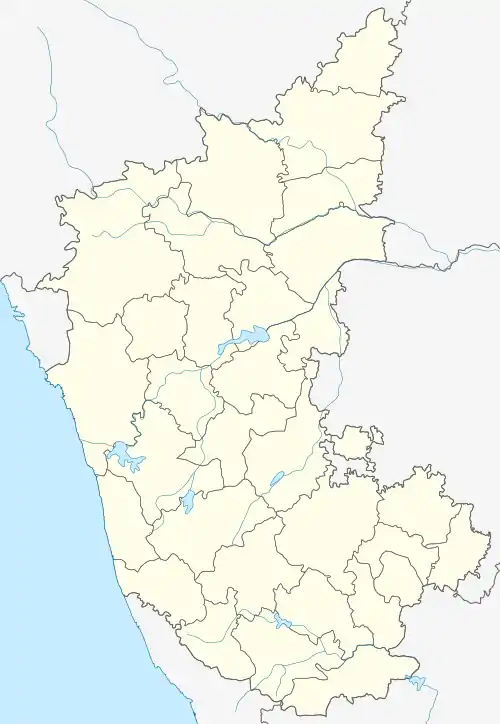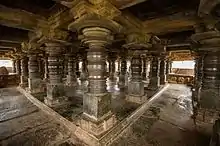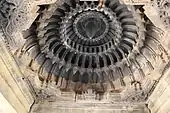Veera Narayana Temple, Belavadi
The Veera Narayana temple is located in Belavadi, a village in the Chikkamagaluru district of Karnataka state, India. The temple was built during the rule of the Hoysala Empire. Known to legend as Ekachakranagara, Belavadi is said to be the place mentioned in Mahabharatha where Pandava prince Bheema killed the demon Bakasura and protected the village and its people. Belavadi is 29 km southeast of Chikmagalur town on the Chikmagalur-Javagal highway. It is a short distance from the famous temple towns of Belur and Halebidu.
| Veera Narayana Temple, Belavadi | |
|---|---|
 | |
| Religion | |
| Affiliation | Hinduism |
| District | Chikkamagaluru |
| Festivals | Narasinha Jayanthi |
| Location | |
| State | Karnataka |
| Country | India |
 Location in Karnataka, India | |
| Geographic coordinates | 13.282594°N 75.99726°E |
| Architecture | |
| Type | Mandir |
| Creator | Veera Ballala II |
| Completed | 1200 CE |
| Temple(s) | +91 9035041518 |


Architecture
This ornate trikuta (three shrined) temple was built in 1200 C.E. by Hoysala Empire King Veera Ballala II. The material used is Soapstone.[1] Each of the three shrines has a complete superstructure (tower on top of shrine) and is one of the largest temples built by the Hoysala kings. While the famous temples at Belur and Halebidu are known for their intricate sculptures, this temple is known for its architecture.[2]
The plan of the temple is unique in that two of the shrines face each other and are located on either side of a wide and spacious open mantapa (hall) containing thirty seven bays.[3] The temple complex has two closed mantapas, one with thirteen bays and another with nine bays, at the end of which is a central shrine. This third shrine is an older construction and exhibits a standard architectural idiom containing all the basic elements of a Hoysala temple.[2] The inner walls of the older shrine are plain, but its roof is well decorated. In all, the temple complex has fifty nine bays (hence it has many pillars), most of which are lathe-turned and bell shaped,[4] while a few have decorative carvings on them. According to Foekema, the outer wall of the temple is of the "old style", with one eaves running around the temple where the superstructure meets the wall of the shrine. Below this are miniature decorative towers on pilasters (aedicule). This is followed by a second eves. A panel of Hindu deities and their attendants (frieze) are below this eves followed by a set of five moldings that form the base of the wall.[5]


The two newer shrines have different plans. One shrine is square in shape while the other is star shaped (stellate). The tower of the shrine has an apex called the kalasha (decorative water-pot like structure) below which are three tiers of decorated miniature roofs.[6] The superstructure over each of three shrines is connected to a low protrusion tower called Sukanasi (tower over the vestibule, called "nose" of the main tower)[7] The Sukanasi consist of two tiers of decorated miniature roofs. In all other aspects the two shrines are identical. All shrines have sculptured decoration on the towers, and the sculptures on the walls are bold and are visible from a distance.[8] However, they are not sharp and impressive from close quarters unlike in other Hoysala temples. The important sculptures with fine finish are that of the Hindu god Krishna dancing on the head of Kalia the serpent, and the Garuda (eagle).[8]
This is a Vaishnava temple and all three shrines have images of the Hindu god Vishnu, though in different forms (avatar). The central shrine (older shrine) has an 8 ft (2.4 m) tall image of Narayana with four hands and is considered one of the best examples of Hoysala art. It is well elaborated with ornamentation and stands on a padmasana (lotus seat). The southern shrine has an 8 ft (2.4 m) tall image of Venugopala (the god Krishna playing a flute) including a garuda pedestal and the northern shrine has a 7 ft (2.1 m) tall image of Yoganarasimha, sitting in a yoga posture. Decorative sculptures such as kirtimukhas (gargoyles) are used to make the shrine (vimana) towers ornate.[9]
Gallery
 Outer mantapa (hall) at Veera Narayana temple in Belavadi
Outer mantapa (hall) at Veera Narayana temple in Belavadi_at_Veeranarayana_Temple_in_Belavadi.jpg.webp) Inner mantapa (hall) in Veeranarayana temple at Belavadi
Inner mantapa (hall) in Veeranarayana temple at Belavadi Close up view of Vimana (shrine and tower over it) in Veera Narayana temple at Belavadi
Close up view of Vimana (shrine and tower over it) in Veera Narayana temple at Belavadi Parapet wall relief sculpture in the Veera Narayana temple at Belavadi
Parapet wall relief sculpture in the Veera Narayana temple at Belavadi The Veera Narayana temple at Belavadi is one of the Hoysala architectural marvels
The Veera Narayana temple at Belavadi is one of the Hoysala architectural marvels Profile of rear shrine in the Veeranarayana temple at Belavadi
Profile of rear shrine in the Veeranarayana temple at Belavadi Profile of rear shrine in the Veeranarayana temple at Belavadi
Profile of rear shrine in the Veeranarayana temple at Belavadi View of front right shrine with rear shrine in the background in the Veeranarayana temple at Belavadi
View of front right shrine with rear shrine in the background in the Veeranarayana temple at Belavadi View of the front left shrine with rear shrine in the background in the Veeranarayana temple at Belavadi
View of the front left shrine with rear shrine in the background in the Veeranarayana temple at Belavadi Profile of the outer mantapa and a shrine in the Veeranarayana temple at Belavadi
Profile of the outer mantapa and a shrine in the Veeranarayana temple at Belavadi Lintel decoration at entrance into inner closed mantapa in the Veeranarayana temple at Belavadi
Lintel decoration at entrance into inner closed mantapa in the Veeranarayana temple at Belavadi Domical bay ceiling art in outer mantapa of the Veeranarayana temple at Belavadi
Domical bay ceiling art in outer mantapa of the Veeranarayana temple at Belavadi Ornate Vimana of the YogaNarasimha shrine in the Veeranarayana temple at Belavadi
Ornate Vimana of the YogaNarasimha shrine in the Veeranarayana temple at Belavadi South Western View of Sri Veera Narayana Temple, Belavadi
South Western View of Sri Veera Narayana Temple, Belavadi
Notes
- Kamath (2001), p136. Quote:"The Western Chalukya carvings were done on green schist (Soapstone). This technique was adopted by the Hoysalas", Takeo Kamiya. "Architecture of the Indian subcontinent, 20 September 1996". Gerard da Cunha-Architecture Autonomous, Bardez, Goa, India. Retrieved 26 November 2006.
- Foekema (1996), p53
- Quote:"A bay is a square or rectangular compartment in the hall", Foekema (1996), p93
- Quote:"This is a common feature of Western Chalukya-Hoysala temples", Kamath (2001), p117
- Quote:"An eaves is a projecting roof, overhanging the wall", Foekema (1996), p93
- Quote:"The Kalasha is the water pot like structure at the peak of the tower", Foekema (2001), p27
- Quote:"Tower on top of vestibule connecting hall and shrine", Foekema (1996), p22
- Foekema (1996), pp54-55.
- I Sesunathan. "Belavadi exudes Hoysala's beauty". Spectrum, Deccan Herald, Tuesday, May 9, 2006. Decan Herald. Archived from the original on 9 March 2007. Retrieved 26 November 2006..
References
- Gerard Foekema, A Complete Guide to Hoysala Temples, Abhinav, 1996 ISBN 81-7017-345-0
- Dr. Suryanath U. Kamath, A Concise history of Karnataka from pre-historic times to the present, Jupiter books, 2001, MCC, Bangalore (Reprinted 2002)
- "Belavadi exudes Hoysala's beauty". Spectrum, Deccan Herald, May 9, 2006. Archived from the original on 9 March 2007. Retrieved 26 November 2006.
- "Architecture of the Indian Subcontinent". Retrieved 26 November 2006.
External links
| Wikimedia Commons has media related to Veera Narayana Temple, Belavadi. |